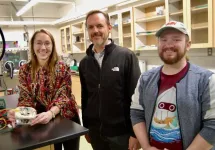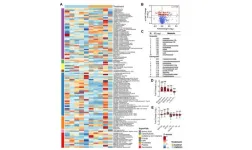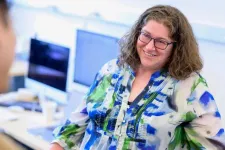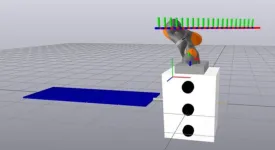(Press-News.org) Today wirelessly connected devices are performing an expanding array of applications, such as monitoring the condition of engines and machinery and remote sensing in agricultural settings. Systems known as the “Internet of Things” (IoT), hold much potential for improving the efficiency and safety of the equipment.
Yet stumbling blocks remain for IoT, thwarting many potential applications. How do you power these devices in situations where and when reliable electrical sources are not practically available?
Research from the University of Utah’s College of Engineering points to a possible solution in the form of a novel type of battery called a pyroelectrochemical cell (PEC).
The device was developed and tested in the research labs of Roseanne Warren and Shad Roundy, both associate professors of mechanical engineering.
“It’s our idea for an integrated device that could harvest ambient thermal energy and convert it directly into stored electrochemical energy in the form of a supercapacitor or battery with applications for the Internet of things and distributed sensors,” said Warren, the senior author on a new study that demonstrates a proof of concept.
“We’re talking very low levels of energy harvesting, but the ability to have sensors that can be distributed and not need to be recharged in the field is the main advantage,” she added. “We explored the basic physics of it and found that it could generate a charge with an increase in temperature or a decrease in temperature.”
The study is the cover feature in the March 21 edition of the journal Energy & Environmental Science, published by the Royal Society of Chemistry.
The device is charged by changing temperatures in the surrounding environment, whether it’s inside a car or aircraft or just under the soil in an agricultural environment. In theory, the PEC could power sensors for IoT applications that would otherwise be impractical to recharge.
A solar cell would work fine in some situations, according to Roundy, a co-author of the study.
“But in a lot of environments, you run into two problems,” said Roundy. “One is that it gets dirty over time. Solar cells have to be kept clean. So in these types of applications, they get dirty and their power degrades. And then there are a lot of applications where you just don’t have sunlight available. For example, we work on soil sensors that we put just under the top surface of the soil. You’re not going to get any sunlight.”
The PEC uses a pyroelectric composite material, as the separator in an electrochemical cell. The material consists of porous polyvinylidene fluoride (PVDF) and barium titanate nanoparticles. This material’s electrical properties change as it’s heated or cooled, which decreases or increases the polarization of the pyroelectric separator
Changing temperatures create an electric field inside the cell, pushing ions around and enabling the cell store to energy.
“It stores electricity in what’s called an electric double layer, which stores the charge in positive and negative layers of ions. This is a glorified capacitor,” said lead author Tim Kowalchik, a graduate student in Warren’s lab. “When you heat and cool the system and you’re storing electrochemical energy, you’re changing the amount of positive or negative ions that are in those layers.”
The new study tested the lab’s theory of how the cell would operate.
“We had a predicted model of function that included what we called an ‘orientation effect’ in the paper,” Kowalchik said. “If we change the reverse the orientation of separator in the cell, it should drive ions the other way. This is a change we can make to the system that will show a different result that we can gather.”
The team’s experiments were set up to determine if the cells would respond as they predicted. Besides the orientation effect, there were heating vs. cooling effects that needed to be tested.
“If you heat the thing one way, you should get something to happen. If you cool it first, you should get something to happen and that should show up differently,” Kowalchik said. “We did that with a process called amperometry. You put a voltage across it and you hold that voltage constant and measure current. Your energy into the system is constant if nothing changes; if there is energy going into the system, the current changes.”
The cell did respond as the team theorized it would, but can it work outside a lab? That’s the next question Warren seeks to address. One of her students is now undertaking circuit modeling to design a cell and optimize its function.
“Now we start to change different parameters,” Warren said. “How can we improve the energy harvesting and storage and the combination of the two? And then after that would be a real-world field demonstration.”
The cell could produce up to 100 microjoules per square centimeter from a single heating/cooling cycle, which is not much energy, but enough to be useful for IoT purposes, according to the research.
“You want to monitor the condition of your car, the condition of machines, the condition of plants and soil and those kinds of things. Those types of sensors are generally going to be quite a bit lower power than your smartwatch or your phone, which have a display and they’re transmitting a lot of data,” Roundy said. “The sensors we’re talking about might just give periodic updates and they operate autonomously. They don’t have an interface or a screen.”
The study, titled “Direct Conversion of Thermal Energy to Stored Electrochemical Energy via a Self-Charging Pyroelectrochemical Cell,” was funded by the National Science Foundation. Also contributing were Fariha Khan and Danielle Horlacher. Horlacher is an undergraduate art student who has been working for Warren’s group on scientific illustrations. She created the above image that displayed on the cover of the journal.
END
This device gathers, stores electricity in remote settings
New research shows the pyroelectrochemical cell, or PEC, developed by University of Utah engineers, harnesses changes in ambient temperature to self-charge, demonstrating its potential for 'Internet of Things' applications.
2024-04-09
ELSE PRESS RELEASES FROM THIS DATE:
AACR: Video educates and connects men to prostate cancer screening options
2024-04-09
SAN DIEGO – As part of a comprehensive effort to improve cancer screenings among diverse communities, Penn Medicine’s Abramson Cancer Center (ACC) Community Outreach and Engagement team developed a culturally sensitive educational video to address prostate cancer screening disparities. In findings shared today at the American Association for Cancer Research (AACR) Annual Meeting 2024 (Abstract LB371), the team showed that the video increased knowledge about prostate cancer and screening, and reduced uncertainty about obtaining prostate ...
Culturally sensitive video targeting Black men may help increase awareness about prostate cancer
2024-04-09
SAN DIEGO – A video designed to educate Black men about prostate cancer resulted in 97% of surveyed participants acknowledging that Black men are at a higher risk of this disease and 93% saying they would get screened, according to a study presented at the American Association for Cancer Research (AACR) Annual Meeting 2024, held April 5-10.
Black men have the highest incidence of prostate cancer in the United States with 184.2 new cases per 100,000 people compared to white men with 111.5 new cases per 100,000 people, according to the National Cancer Institute’s Surveillance, ...
St. Jude survivorship portal brings researchers ‘one-click’ away from discovery
2024-04-09
(MEMPHIS, Tenn. – April 9, 2024) Scientists from St. Jude Children’s Research Hospital today announced the St. Jude survivorship portal — the first data portal for sharing, analyzing and visualizing pediatric cancer survivorship data. Details on the portal and its ability to facilitate breakthroughs in pediatric cancer survivorship research were published today in Cancer Discovery, a journal of the American Association for Cancer Research.
The survivorship portal is a big-data platform that incorporates clinical and genomic information, creating an unprecedented research system. The portal integrates three dimensions ...
System uses artificial intelligence to detect wild animals on roads and avoid accidents
2024-04-09
Just as in Brazil drivers can be warned of traffic congestion ahead or a vehicle parked on the hard shoulder, notifications may soon pop up on their smartphone or on their car’s computer screen to warn them in real time that an anteater, wolf or tapir is crossing the highway. No human will necessarily need to see the animal in question or press a control button to send the warning.
For this to be possible, a key step is construction of a computer vision model that automatically detects Brazilian wild animals. Researchers ...
Has remote work changed how people travel in the U.S?
2024-04-09
The prevalence of remote work since the start of the Covid-19 pandemic has significantly changed urban transportation patterns in the U.S., according to new study led by MIT researchers.
The research finds significant variation between the effects of remote work on vehicle miles driven and on mass-transit ridership across the U.S.
“A 1 percent decrease in onsite workers leads to a roughly 1 percent reduction in [automobile] vehicle miles driven, but a 2.3 percent reduction in mass transit ridership,” says Yunhan Zheng SM ’21, PhD ’24, an MIT postdoc who is co-author of the study.
“This is one of the first studies that identifies the causal effect ...
UC Irvine scientist helps link climate change to Madagascar’s megadrought
2024-04-09
Irvine, Calif., April 9, 2024 — A University of California, Irvine-led team reveals a clear link between human-driven climate change and the years-long drought currently gripping southern Madagascar. Their study appears in the Nature journal Climate and Atmospheric Science.
“Using remotely sensed observations and climate models, we could see evidence that climate change is affecting the hydrological cycle in southern Madagascar, and it’s likely going to have big implications for the people that live there and how they grow their food,” ...
CMS121 mitigates aging-related obesity and metabolic dysfunction
2024-04-09
“[...] CMS121 applicability could be expanded from a geroneuroprotector drug to a metabolic drug [...]”
BUFFALO, NY- April 9, 2024 – A new research paper was published in Aging (listed by MEDLINE/PubMed as "Aging (Albany NY)" and "Aging-US" by Web of Science) Volume 16, Issue 6, entitled, “CMS121: a novel approach to mitigate aging-related obesity and metabolic dysfunction.”
Modulated by differences in genetic and environmental factors, laboratory mice often show progressive weight gain, eventually leading to obesity and metabolic dyshomeostasis. ...
AACR: How cellular plasticity drives cancer metastasis
2024-04-09
About 90% of deaths from cancer are a result of metastasis — that is, from cancer’s ability to spread from an initial primary tumor to seed new tumors throughout the body, often in the lungs, liver, and brain.
And metastasis relies on cancer cells’ ability to adapt to different tissue environments throughout the body by gaining improper access to a variety of playbooks stored in our genetic code — including gene programs that are generally available only during early stages of human development.
Today, researchers at Memorial Sloan Kettering Cancer Center (MSK) are using innovative approaches like single-cell sequencing technology ...
Free public education event on neuromodulation therapies to be held at Vancouver Convention Centre
2024-04-09
Vancouver, BC – The Canadian Neuromodulation Society and the International Neuromodulation Society (INS) are delighted to announce a public education event, "Understanding Neuromodulation of the Brain and Spinal Cord”.
This complimentary event is scheduled to take place at the Vancouver Convention Centre, East Building, on Saturday, May 11, from 13:30 to 18:00, during the 16th INS World Congress.
Aimed at patients, their families, and friends dealing with conditions such as chronic pain, Parkinson’s disease, and tremor, this event is ...
SwRI demonstrating robotics for in-space manufacturing at Space Symposium
2024-04-09
SAN ANTONIO — April 9, 2024 — Southwest Research Institute has invested in new space robotics capabilities to help the space industry pave the way for in-space servicing, assembly and manufacturing (ISAM) capabilities. SwRI’s Intelligent Systems Division will demonstrate new ISAM-focused research at the 38th Space Symposium, April 8-11, in Colorado Springs. Visit SwRI at Booth #237.
“SwRI is developing solutions to leverage Earth-based industrial robotics with advanced automation and simulation so we can help clients develop new capabilities for the complex conditions ...
LAST 30 PRESS RELEASES:
First Editorial of 2026: Resisting AI slop
Joint ground- and space-based observations reveal Saturn-mass rogue planet
Inheritable genetic variant offers protection against blood cancer risk and progression
Pigs settled Pacific islands alongside early human voyagers
A Coral reef’s daily pulse reshapes microbes in surrounding waters
EAST Tokamak experiments exceed plasma density limit, offering new approach to fusion ignition
Groundbreaking discovery reveals Africa’s oldest cremation pyre and complex ritual practices
First breathing ‘lung-on-chip’ developed using genetically identical cells
How people moved pigs across the Pacific
Interaction of climate change and human activity and its impact on plant diversity in Qinghai-Tibet plateau
From addressing uncertainty to national strategy: an interpretation of Professor Lim Siong Guan’s views
Clinical trials on AI language model use in digestive healthcare
Scientists improve robotic visual–inertial trajectory localization accuracy using cross-modal interaction and selection techniques
Correlation between cancer cachexia and immune-related adverse events in HCC
Human adipose tissue: a new source for functional organoids
Metro lines double as freight highways during off-peak hours, Beijing study shows
Biomedical functions and applications of nanomaterials in tumor diagnosis and treatment: perspectives from ophthalmic oncology
3D imaging unveils how passivation improves perovskite solar cell performance
Enriching framework Al sites in 8-membered rings of Cu-SSZ-39 zeolite to enhance low-temperature ammonia selective catalytic reduction performance
AI-powered RNA drug development: a new frontier in therapeutics
Decoupling the HOR enhancement on PtRu: Dynamically matching interfacial water to reaction coordinates
Sulfur isn’t poisonous when it synergistically acts with phosphine in olefins hydroformylation
URI researchers uncover molecular mechanisms behind speciation in corals
Chitin based carbon aerogel offers a cleaner way to store thermal energy
Tracing hidden sources of nitrate pollution in rapidly changing rural urban landscapes
Viruses on plastic pollution may quietly accelerate the spread of antibiotic resistance
Three UH Rainbow Babies & Children’s faculty elected to prestigious American Pediatric Society
Tunnel resilience models unveiled to aid post-earthquake recovery
Satellite communication systems: the future of 5G/6G connectivity
Space computing power networks: a new frontier for satellite technologies
[Press-News.org] This device gathers, stores electricity in remote settingsNew research shows the pyroelectrochemical cell, or PEC, developed by University of Utah engineers, harnesses changes in ambient temperature to self-charge, demonstrating its potential for 'Internet of Things' applications.






